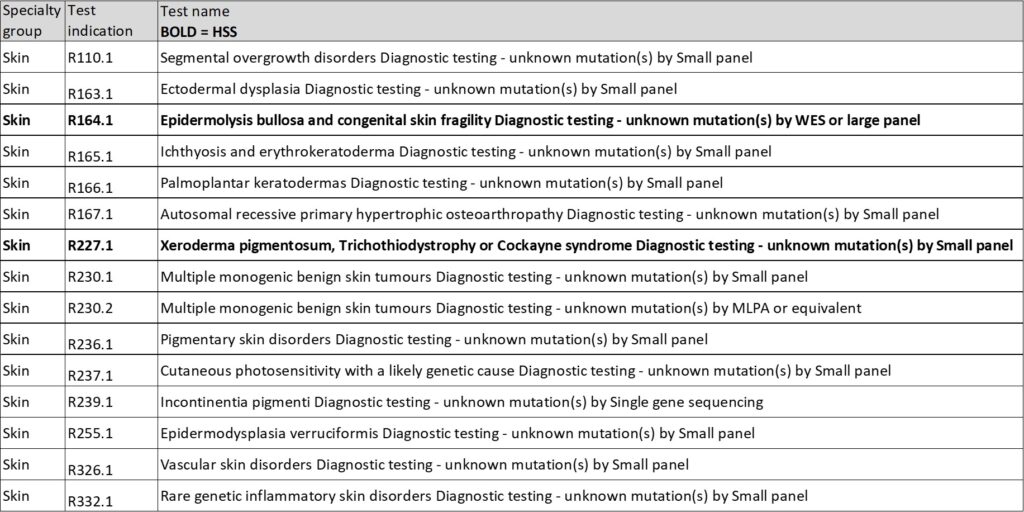Dermatology
Skin testing
The National Diagnostic Epidermolysis Bullosa laboratory is a UKAS accredited (Laboratory ID: 8688, UKAS: Search Accredited Organisations) laboratory based at Guy’s Hospital and is an integral part of the South East Genomics Laboratory Hub. The laboratory is also part of the national highly specialised services, commissioned by NHS England (formally NSCAG) in 2005, and is the only national referral centre for EB patient laboratory diagnosis.
The laboratory provides specialist genomic testing for skin disorders (genodermatoses) and provides the full range of tests described in the National Genomics Test Directory with the exception of:
- R227.2 – Xeroderma pigmentosum, Trichothiodystrophy or Cockayne syndrome Diagnostic testing – unknown mutation(s) by DNA repair defect testing.
- R327.1 – Mosaic skin disorders – deep sequencing Diagnostic testing – unknown mutation(s) by Small panel
Genodermatoses is a group of inherited skin disorders associated with structure and function abnormalities of the skin. Many genodermatoses present with multisystem involvement leading to increased morbidity and mortality. Genetic heterogeneity is also very common, and molecular genetics diagnosis of these diseases requires expert knowledge and experience, both in clinic and in molecular genetics.
EB is a group of rare inherited blistering disorders that affects skin and mucous membranes, causing skin fragility. Clinically it is a very diverse group of conditions, from relatively limited areas of skin blistering and a normal life span, to severe and generalised blistering.
The National Diagnostic Epidermolysis Bullosa laboratory has international reputation for knowledge and experience in the diagnosis of genodermatoses. We are a well-established team of diagnostic scientists with long term experiences in molecular genetics diagnosis, and with outstanding continuing professional development (CPD). Under clinical supervision of Professor John McGrath and Professor Jemima Mellerio, the laboratory employs Whole Exome Sequence (WES) as the testing method for all samples and provides personalised report for every patient, including advice for prenatal diagnosis.
The diagnostic EB service was developed from academic and clinical studies carried out over more than 30 years at the St John’s Institute of Dermatology, and has an active research and development programme with close affiliation to the Genetic Skin Disease Group (Kings College London), led by Professor John McGrath.
SE GLH: Dermatology request form
- Please fill in ALL parts in ‘Patient’s demographic information’ on the referral form clearly. Indicate who should receive the report and provide an NHS email address for receipt of the report.
- Please give as much clinical information, in particular, indicate if the sample is from an affected patient or a possible carrier, consanguinity. Also provide any known family history.
- If the patient’s clinical symptoms do not fit any test listed in the directory completely, please choose the closest fit, or select ‘other’, but include a clear description of the clinical symptoms.
- Please contact the laboratory beforehand for any prenatal diagnosis, as the laboratory only accepts prenatal diagnosis when the familial mutation(s) has been identified.
Requirements
Please note that the laboratory will reject any samples that do not meet the stated requirements e.g. no patient name and date of birth on referral form or specimen container, mismatched name on referral form and specimen container, insufficient sample volume, incorrect collection media or container, sample too old, specimen type on request form does not match contents of specimen container, clinical information not provided, no consent indicated.
Please also indicate if there is any mosaicism presented, as this may affect the interpretation of the result.
Turnaround times
84 days
Key contacts
Dr Lu Liu, Laboratory Lead Scientist
Professor John McGrath and Professor Jemima Mellerio, Clinical Leads
For any clinical or scientific queries please contact the EB laboratory on 020 7188 7229 between the hours of 9am to 4.30pm, Monday to Friday.
SE GLH: Record of Discussion form
The Record of Discussion form can be downloaded and used to guide and record the patient’s consent. This should be saved in local patient records and does not need to be sent with the request form.
Lab address and opening hours
Within working hours (09:00-17:00 Monday to Friday) samples should be sent to:
South East GLH
Genetics Specimen Reception
5th floor Tower Wing
Guy’s Hospital
London
SE1 9RT
Outside of working hours samples should be sent to:
Central Specimen Reception
4th floor Southwark Wing
Guy’s Hospital
London
SE1 9RT

